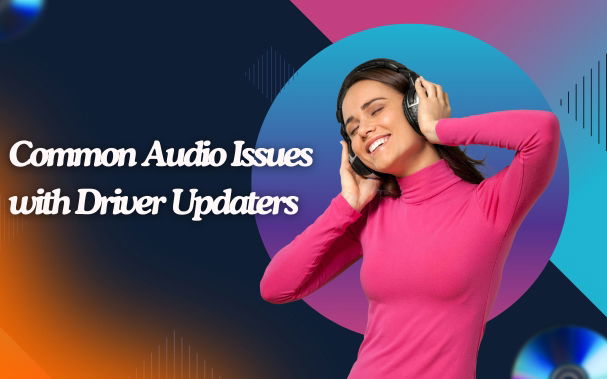Common Audio Issues with Driver Updaters
While Driver Updaters are invaluable tools for maintaining your computer's health, users may sometimes encounter audio-related issues as a result of using these applications. Audio problems can be frustrating, especially when you're relying on your computer for entertainment or work. This article outlines common audio issues that can arise when using driver updaters and offers solutions to troubleshoot these problems.

Common Audio Issues
Incorrect Driver Selection
One of the primary issues users face is the incorrect identification of their audio device. Driver updaters may sometimes recommend or install drivers that are not suitable for your hardware, leading to degraded audio quality or malfunction. For example, if your system is running a high-end audio card, but the updater installs a generic driver, you may notice significant drops in sound clarity or even a total lack of audio output.
Driver Conflicts
Installing multiple versions of the same driver can create conflicts, which may manifest as audio distortions or complete sound loss. It’s essential to ensure that only one version of a driver is active at a time. When conflicts occur, it can confuse the operating system regarding which driver to use, leading to frustrating audio issues.
Incomplete Installation
Sometimes, a driver updater may fail to install all necessary components, resulting in audio issues. Missing files can prevent your audio device from functioning properly, leading to frustrating experiences. This incomplete installation can occur due to network interruptions or software bugs in the driver updater tool itself, causing a vital component to be overlooked during installation.
System Instability
In rare instances, an update can cause system instability, leading to crashes or errors. This can further complicate audio issues, as the operating system may struggle to communicate effectively with hardware components. System instability can result from an incompatible driver version or conflicts between drivers and other software applications running on your PC.
Troubleshooting Audio Issues
If you encounter audio problems after using a driver updater, consider the following troubleshooting steps:
Verify Driver Installation
First, check that the correct audio driver is installed and enabled. You can do this through the Device Manager in Windows 10. Look for any yellow exclamation marks next to your audio device, which indicate potential issues. If an incorrect driver is installed, you may need to uninstall it and install the appropriate one manually or via a reliable Audio Driver Updater.
Check Device Connections
Ensure that all audio device connections are secure. Loose cables can lead to sound issues. If you're using external speakers or headphones, verify that they are plugged in correctly. Additionally, consider testing different audio ports to rule out port-specific issues.
Disable Conflicting Software
Sometimes, third-party audio applications can interfere with your audio output. Temporarily disable or uninstall any such applications to see if the problem resolves. This is especially important if you have multiple audio enhancement applications installed, as they can conflict with each other.
Restart Your Computer
A simple restart can often clear temporary glitches and restore audio functionality. This step is often overlooked but can be very effective. Restarting your PC can reset the audio drivers and re-establish the connection between your operating system and audio hardware.
Consult Manufacturer's Documentation
If problems persist, refer to the documentation provided by your audio device or motherboard manufacturer. They often include specific troubleshooting tips and guidance. Additionally, manufacturer websites may offer updated drivers specifically designed for your hardware.
Best Practices for Using Driver Updaters
To reduce the likelihood of audio issues when using driver updaters, consider the following best practices:
Research and Choose Reputable Tools
Not all driver updaters are created equal. Select a reliable Audio Driver Updater with positive user reviews and a solid reputation for performance. Look for features such as automatic backups, restore points, and compatibility checks.
Create a Restore Point
Before updating any drivers, create a system restore point. This allows you to revert to a previous state if the update causes issues. This precaution is crucial for quickly addressing any audio problems that may arise post-update.
Backup Important Data
Always back up your critical files before making changes to your system. This precaution ensures that you won’t lose important data due to unforeseen problems. Utilize external drives or cloud storage solutions to keep your files safe.
Monitor for Issues
After updating drivers, keep an eye on audio performance. If you notice any issues, take immediate action to troubleshoot and resolve them. This proactive approach can help you identify problems before they escalate into significant disruptions.
Stay Informed
Regularly check for updates from your audio device manufacturer and subscribe to newsletters or forums related to your hardware. Being informed can help you preemptively address potential issues that could arise from new updates.
Conclusion
Driver updaters are essential for maintaining your system's health, but they can sometimes lead to audio issues. By understanding common problems and following troubleshooting steps, you can minimize the impact of these issues on your computing experience. Implementing best practices for using driver updaters can help ensure that your audio experience remains smooth and enjoyable. Staying proactive about your driver management not only enhances your audio performance but also contributes to the overall stability and functionality of your Windows 10 system. With these insights, you can navigate the challenges of audio management and maintain a seamless computing experience.
